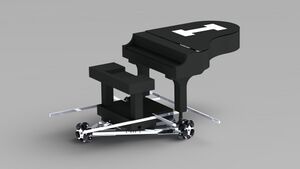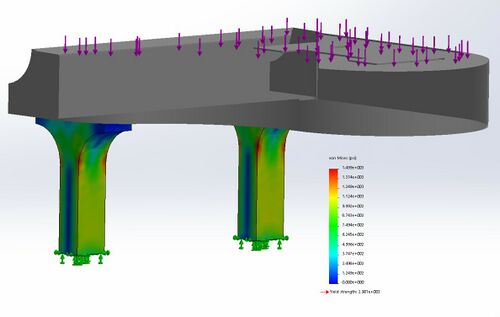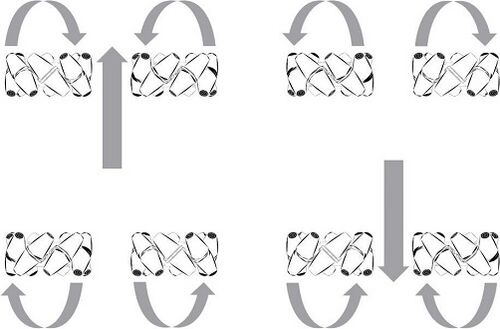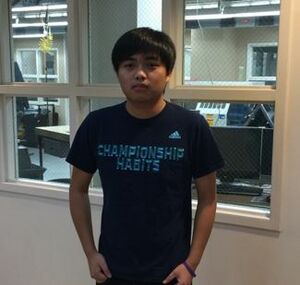Bandbeesten: The Legacy Goes On
| Total Bandbeesten Assembly
| |
| Sponsors | |
| Team Name | Encore |
| Duration | Summer - Fall 2017 |
| Director of Athletic Bands (Client) | Spencer Martin |
| Faculty Advisers | Dr. Edwin Odom, Dr. Beyerlein |
| Graduate Student Adviser | Coleton Bailey |
| Team Members |
|
The Bandbeesten project is back yet again at the University of Idaho. This project is a Kaizen event (continuously improving) involving the Mechanical Engineering Department and the Vandal Marching Band. This marks the seventh consecutive year of the collaboration. This year incorporates improvements to the former platform as well as design and fabrication new fixtures for the marching band's new sousaphones.
Background[edit | edit source]
The Band-Beesten project was started in 2011 by Dr. Edwin Odom, Professor of Mechanical Engineering, and Dr. Daniel Bukvich, Professor of Percussion and Music Theory. The goal of their collaboration was to create a full drum set that could easily be played and moved by a single person during marching band performances. Since then, the project has been revisited every year with new goals to improve old design and create a new product for the Sound of Idaho. The 2016-2017 acedemic year will be the 6th consecutive year of the project.
Work in the fall of 2011 consisted of researching ideas for a powered platform to assist in parade and marching band performances. The team worked solely on research for a proof of concept and did not build a physical prototype. For more in depth design details refer to the Team Drum Roll webpage.
The design team of 2012-2013 made progress with the BandBeesten's design. Dan Mathewson, a UI graduate student, designed a robotic power driven front ball wheel to enable the machine to receive commands through the operator's body movements. More information on this design can be found in Dan Mathewson's thesis . The 2012 design team made significant progress in designing a human interface and powered movement for the BandBeesten.
In the 2013-2014 academic year, a new team started designing a BandBeesten design that would be light weight and have low friction wheels. This design relied only on man-power and did not have any assisting motors. The team also produced a marketing video for the UI Marching Band using 3D printed models, Legos, and a stop-motion video design. More information about this design can be found at their page.
In the 2015-2016 academic year, a team made great progress updating the BandBeesten's platform. The base was redesigned and now includes three motors that each spin an omni wheel assembly. A wireless remote control now commands the platform. An Arduino microcontroller inputs the direction of the joysticks and outputs signal to the motors. More information about the design and project can be found on the Bandbeesten Legacy' page.
In the 2016-2017 academic year a new team completely redesigned and fabricated a new piano structure as well as made improvements to the motor driver code and wiring harness. More information about the design and project can be found on the Bandbeesten: The Legacy Continues page.
Sousaphone Stands[edit | edit source]
Problem Statement[edit | edit source]
Along with the motorized piano, this year's Bandbeesten project catering to the sousaphone players of the marching band. The Band Department purchased twenty brand new sousaphones for the marching band in the summer of 2017 and need a way to keep them safe in the bleachers of the Kibby Dome while the they are not in use during the football games. The fixture will be rigid and stable enough to hold the 30-40 pound instrument while still remaining compact enough to transport easily and attach to the bleachers in the Kibby Dome.
Design Specifications[edit | edit source]
Sousaphone Stand Prototyping[edit | edit source]
| Prototype Version 1 | Prototype Version 2 | Overview |
|---|---|---|
Initial Prototype Versions
| ||
Advanced Prototype
|
Final Sousaphone Stand Design[edit | edit source]
| Photo | Photo | Overview |
|---|---|---|
Final Protoype
|
Sousaphone Stand Production[edit | edit source]
| Photo | Photo | Overview |
|---|---|---|
Early Production
| ||
Mid Production
| ||
Final Delivery
|
BandBeesten Piano[edit | edit source]
Problem Statement[edit | edit source]
The Bandbeesten project was handed down to this team as a functioning assembly. That being said there are many improvements that can be made. The structure of the piano needs to be reinforced if there is any plan for extended use. The wiring harness also needs to be simplified and well labeled to avoid confusion during set-up, operation, and shut-down. Lights and possible fog machine also be added to the assembly to improve showmanship and flare to the halftime performance.
Project Goals[edit | edit source]
- Maintain Bandbeesten from previous projects.
- Refine designs to ensure they are robust enough for a possible "hand-off" to the marching band.
- Design a cost effective, ridged way for the marching band to hold sousaphones in the bleachers when not in use.
- Add LED lights to the piano to enrich showmanship and attract attention.
Design Specification[edit | edit source]
|
| |
|---|---|
Improvements[edit | edit source]
Stress Analysis[edit | edit source]
| Photo | Overview |
|---|---|
Overview
Assumptions:
|
Piano Reinforcement[edit | edit source]
| Photo | Photo | Overview |
|---|---|---|
Overview
|
Illuminated "I"[edit | edit source]
| Photo | Photo | Overview |
|---|---|---|
Overview
|
Motor Driver Switches[edit | edit source]
| Inital | Final | Overview |
|---|---|---|
Overview
|
Next Generation Concept[edit | edit source]
Our plan for this semester was to design, assemble, and program a fully functional scale model of the system. The design was built around VEX Robotics Mecanum Wheels. The main purpose of our scale model is to demonstrate the functionality of the system to Dr. Odom and future senior engineering students to create interest in this potential senior project and to get funding for a full scale version. Our design is simple, we need four VEX Mecanum wheels, four Motors, four motor-controllers and a base to be machined out of extruded aluminum. We spent the majority of the last few months of the semester designing, coding, and testing this unit so we could present this working prototype.
| Photo | Photo | Overview |
|---|---|---|
Design Specifications
|
Team Members[edit | edit source]
| Photos | Bio | Discipline |
|---|---|---|
| Chris Baker: I am a senior mechanical engineering student at The University of Idaho. I am from Coeur d’ alene Idaho and plan to stay in the Northwest after I graduate. I plan on working in the automotive or aerospace industry but am open to working in other areas. My main interests include hiking, hunting, snowboarding, and anything automotive or motor sport. | ME | |
| Naif Bawayan: I am currently senior student in mechanical engineering at the University of Idaho, from Saudi Arabia, graduating in August 2017. My goal is to find an opportunity in company that will allow me for personal and professional growth, where I can use my education, skills of engineering. During my free time, I love to spend time with my family, love the outdoors, travelling, and I am passionate for rides on a motorcycle. | ME | |
| Riley Yager: My name is Riley Yager and I am currently a senior Mechanical engineer at the University of Idaho. I grew up in Tacoma Washington, and once I graduate in the fall, I plan on moving back and starting work somewhere in Seattle. My other hobbies include playing intermural basketball and lifting weights, otherwise you’ll find me somewhere in the Gauss-Johnson engineering building. | ME | |
| Huijie Zhang (Jay): I am graduating Spring 2018 with a bachelor's degree in Mechanical Engineering, from China. I will go back to China after graduation. I chose this major because I like designing things and I enjoy building things. I love soccer and I’m a big fan of Real Madrid. | ME |
Document Archive[edit | edit source]
Design Expo Presentation[edit | edit source]
File:2017 FinalPresentation.pdf







